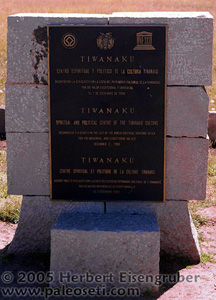
|
Tiahuanacu is a
"UNESCO World Heritage Site".
In the past hundred years the ancient ruins served as a source for
stones to
build houses for the local community and therefore are lot of damage
was done
to the site.
There are delicately carved stones lying around everywhere piles and
piles of
them.
|
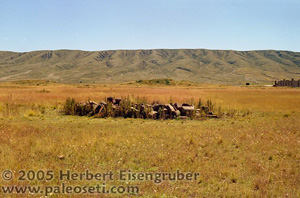 |
Right after you enter
the site you will see how careless the archeologists worked in
Tiahuanacu.
Piles like those are everywhere. The carved stones are just thrown
together
without context, rhime or reason. |
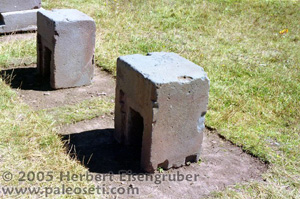 |
Mysteriously carved
stones are standing right and left on the path to the ruins. The
archeologists
just place them there, they haven't been there originally.
|
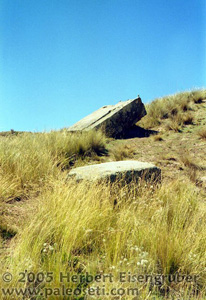
|
Not far from the
entrance there are these two lonely blocks. They must weigh many
tonnes. It
almost looks like they where thrown around by a big explosion or
something. The
blocks are carved with extreme precision - just like the most granit
blocks in
Tiahuanacu. |
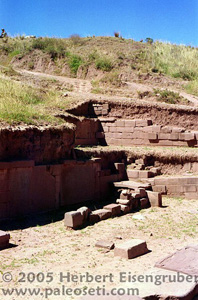
|
There two different
types of building materials used in Tiahuanacu: Redish Sandstone and
greenish-blue Andesit,
a superhard
type of granit.
The much softer sandstone was used for "everyday" buildings. On this
photo you can see the remnants of such a building. |
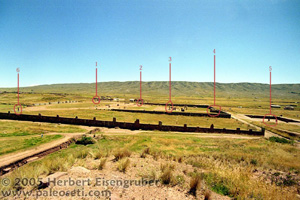 |
This wide-angle shot
gives you a good overview over the main site Kalasaya, and Tiahuanacu
(or
what's left). Click on the image to get a new window with a higher
resolution
image and the according numbers and explanations:
1. The gate of the sun
2. The "Accoustic stone" - see below
3. The Ponce
Monolith
4. Reconstructed gate
5. The "The semi-subterrenian" temple
6. The Monolith El
Fraile |
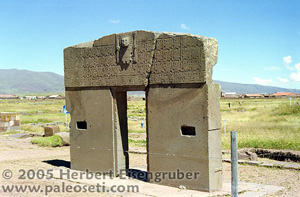 |
The famous gate of the Sun.
I made a separate page for it. Please
click here. |
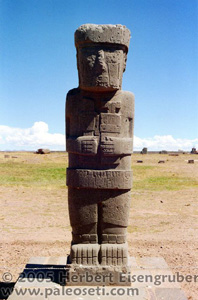
|
The Ponce Monolith. |
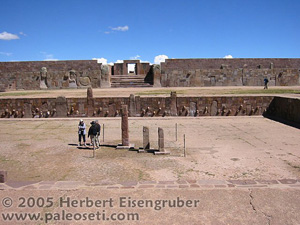 |
Here a closer view at
the "semi-sub-terrenian temple". It's built with astronomical
alignments in mind.
|
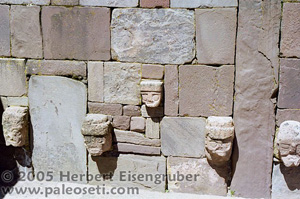 |
The heads in the
walls (like pretty much everything else reconstructed wrongly, they
haven't
been there originally) show different facial and racial features. Most
of them
have modern looking helmets. Also a common trait are the square,
robot-like
eyes of some of them.
|
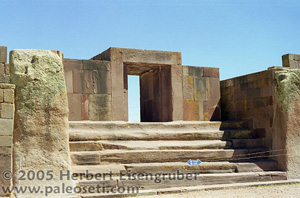 |
The reconstructed
gate within the reconstructed wall. By the way that reconstructed wall
that
surrounds the part of Tiahuanacu called Kalasasaya
is a total fantasy product of the archeologists. Nobody
really knows how it looked and if there ever was a wall. The earliest
photos
and descriptions of Tiahuanacu were made by Max Uhle and Stuebel in
their book
"Die Ruinenstaette von Tiahuanacu". All it shows are the big
Megaliths in between the reconstructed walls. The reason I don't
believe that
there was ever a wall there is the fact that those big megaliths have
carvings
INSIDE were now the "reconstructed" wall is. |
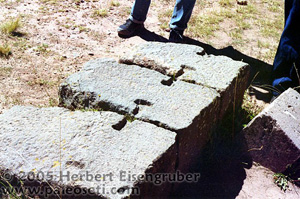 |
In Tiahuanacu and
Puma Punku one can often see blocks of granit, that were held together
with
metal clamps. You can see that in the photo on the left. This ingenius
method
was used by the ancients all over the world. Who were the teachers? |
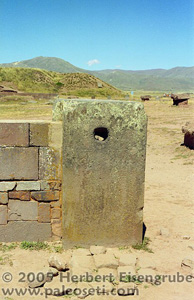
|
Another sensation in
Tiahuanacu!
Just a stone with a hole? But that hole is something special! This
monolith
features a weirdly cut hole in its upper half.
At first sight one wouldn't think much about it, but if you press your
ear to
this hole incredible things happen: Normal voices and sounds ca. 300m
(yards)
away are heard crystal clear, just like an amplifier! But that's not
all. If
one speaks through that hole the voice gets distorted. A man's voice
will
sounds very "robot" like.
|
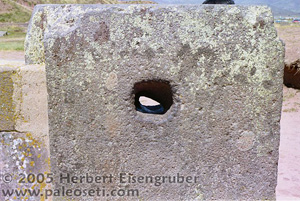 |
Here a closer view at
this "accustic miracle" of Tiahuanacu. You can see how precise it was
cut and carved. The accustic properties are not there by coincidence!
Whoever
made this had an incredible knowledge about physics and accustics.
|

